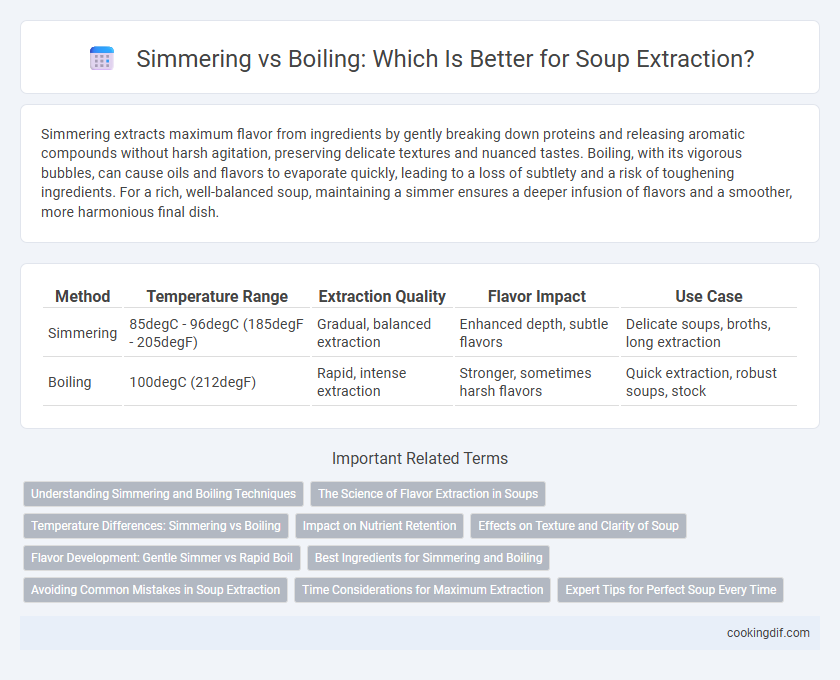Simmering extracts maximum flavor from ingredients by gently breaking down proteins and releasing aromatic compounds without harsh agitation, preserving delicate textures and nuanced tastes. Boiling, with its vigorous bubbles, can cause oils and flavors to evaporate quickly, leading to a loss of subtlety and a risk of toughening ingredients. For a rich, well-balanced soup, maintaining a simmer ensures a deeper infusion of flavors and a smoother, more harmonious final dish.
Table of Comparison
| Method | Temperature Range | Extraction Quality | Flavor Impact | Use Case |
|---|---|---|---|---|
| Simmering | 85degC - 96degC (185degF - 205degF) | Gradual, balanced extraction | Enhanced depth, subtle flavors | Delicate soups, broths, long extraction |
| Boiling | 100degC (212degF) | Rapid, intense extraction | Stronger, sometimes harsh flavors | Quick extraction, robust soups, stock |
Understanding Simmering and Boiling Techniques
Simmering and boiling are distinct cooking techniques critical for optimal soup extraction, where simmering maintains the liquid just below boiling point around 185degF to 205degF to gently extract flavors without breaking down ingredients. Boiling occurs at 212degF, causing vigorous bubbling that can lead to the rapid breakdown of delicate proteins and vegetables, resulting in a less clear broth. Understanding these temperature differences ensures maximum nutrient retention and enhanced flavor concentration in each simmered or boiled soup recipe.
The Science of Flavor Extraction in Soups
Simmering is ideal for flavor extraction in soups because it allows volatile compounds and nutrients to gradually infuse into the liquid without breaking down delicate ingredients or causing cloudiness. Boiling, at 212degF (100degC), agitates the broth aggressively, which can emulsify fats and proteins, leading to a dull taste and less clear soup. Understanding the chemistry behind heat control helps preserve aromatic oils and soluble compounds, enhancing depth and complexity in soup flavors.
Temperature Differences: Simmering vs Boiling
Simmering typically occurs at temperatures between 185degF to 205degF (85degC to 96degC), providing gentle heat that allows flavors and nutrients to extract slowly without damaging delicate ingredients. Boiling reaches 212degF (100degC), causing rapid agitation that can break down solids too quickly and lead to flavor loss or cloudy broth. Controlled simmering preserves the clarity and depth of soup by maintaining optimal extraction temperatures.
Impact on Nutrient Retention
Simmering soup at a low temperature between 185degF and 205degF preserves delicate vitamins, such as vitamin C and B-complex, by reducing nutrient degradation caused by intense heat. Boiling, which occurs at 212degF, accelerates the breakdown of sensitive nutrients and can cause the leaching of water-soluble vitamins into the cooking liquid. Consequently, simmering optimizes nutrient retention while maintaining flavor extraction, making it the preferred method for nutrient-rich soup preparation.
Effects on Texture and Clarity of Soup
Simmering soup allows flavors to meld gradually while preserving the delicate texture of ingredients, resulting in a clearer broth with minimal cloudiness. Boiling causes vigorous agitation that can break down vegetables and proteins rapidly, leading to a murkier liquid and mushier texture. Maintaining a simmer temperature around 185-205degF ensures optimal extraction of flavors without compromising the soup's clarity or ingredient integrity.
Flavor Development: Gentle Simmer vs Rapid Boil
Simmering allows for gradual extraction of flavors, preserving delicate aromatics and resulting in a richer, well-rounded soup. In contrast, rapid boiling agitates ingredients, which can cause the breakdown of subtle flavor compounds and lead to a harsher taste. Maintaining a gentle simmer ensures optimal flavor development by enhancing depth without compromising the soup's complexity.
Best Ingredients for Simmering and Boiling
Simmering extracts rich flavors from delicate ingredients like herbs, vegetables, and lean meats without breaking down their textures, making it ideal for broths and clear soups. Boiling is better suited for tough cuts of meat, bones, and starchy vegetables, as the high temperature quickly releases collagen and starches, producing a hearty, robust stock. Using fresh herbs and tender vegetables in simmering preserves their aromatic qualities, while boiling maximizes gelatin extraction from bones, enhancing soup viscosity and mouthfeel.
Avoiding Common Mistakes in Soup Extraction
Simmering soup at a gentle temperature between 185degF and 205degF ensures optimal extraction of flavors and nutrients without overcooking delicate ingredients, preserving clarity and texture. Boiling, which occurs above 212degF, can break down proteins and vegetables too rapidly, leading to cloudy broth and loss of essential nutrients. Avoid common mistakes by maintaining a consistent simmer to release maximum flavor compounds while preventing emulsification that causes greasiness and off-tastes.
Time Considerations for Maximum Extraction
Simmering soup at a low temperature allows for gradual extraction of flavors and nutrients, often requiring 30 minutes to several hours depending on ingredients like bones or tougher vegetables. Boiling accelerates the process but risks breaking down delicate flavors and nutrients, typically taking 10 to 20 minutes for lighter soups. Optimal extraction balances simmering time to maximize depth and clarity without overcooking or diluting the broth.
Expert Tips for Perfect Soup Every Time
Simmering gently extracts rich flavors from ingredients without breaking down delicate textures, making it essential for achieving a balanced soup. Boiling causes rapid agitation that can toughen proteins and dilute flavors, often resulting in a less refined broth. Expert chefs recommend maintaining a steady simmer to unlock the full depth of herbs, vegetables, and meats, ensuring a perfect soup every time.
Simmering vs Boiling for extraction Infographic

 cookingdif.com
cookingdif.com